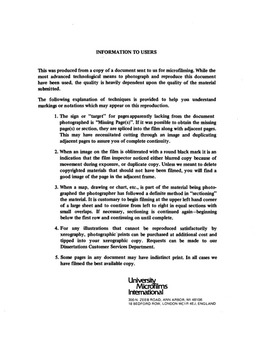| dc.contributor.author | Miller, Gary David, | en_US |
| dc.date.accessioned | 2013-08-16T12:28:19Z | |
| dc.date.available | 2013-08-16T12:28:19Z | |
| dc.date.issued | 1980 | en_US |
| dc.identifier.uri | https://hdl.handle.net/11244/4837 | |
| dc.description.abstract | This study involved a laboratory examination of the phosphorus interactions between the sediment and water as they occur on a diurnal basis in a waste stabilization pond under summer conditions in the southcentral U.S. At this time of the year light and temperature conditions combine to cause diurnal extremes in the dissolved oxygen concentration and pH in ponds which affects phosphorus chemistry. | en_US |
| dc.description.abstract | The current understanding of phosphorus chemistry in lakes as pertinent to waste stabilization ponds was reviewed. An examination of factors influencing phosphorus chemistry and research related to phosphorus chemistry in waste stabilization ponds was presented. No studies were found that have determined the diurnal movement of phosphorus or the fate of phosphorus in a pond under summer conditions. | en_US |
| dc.description.abstract | Three divided steel tanks of 300 gallon capacity were each used as a model pond system. One tank was loaded at a rate of 30 pounds BOD(, 5) per acre per day. The other two were loaded at a rate of 50 pounds BOD(, 5) per acre per day. Synthetic sewage was used. Three inches of sediment was placed in each tank. Other environmental factors of lighting, temperature, wind writing, retention time and liquid depth were also simulated. The tanks were operated for several months during the acclimation phase and were sampled for materials balance of radiophosphorus and for correlation analysis during the 40 day operational phase. | en_US |
| dc.description.abstract | Results indicated that the radiophosphorus concentration varied significantly as the total phosphorus and orthophosphate concentrations in each tank. Eight materials balance measurements were made in each tank. Most of the radiophosphorus remained in the bulk water and tanks with higher loading rates had a larger portion in the sediment and on the walls. In all tanks the sediment gained radiophosphorus during oxidized conditions and contained less radiophosphorus during reducing conditions. | en_US |
| dc.format.extent | xiii, 235 leaves : | en_US |
| dc.subject | Energy. | en_US |
| dc.subject | Engineering, Sanitary and Municipal. | en_US |
| dc.title | Phosphorus chemistry under aerobic and anaerobic conditions in model two-celled waste stabilization ponds. | en_US |
| dc.type | Thesis | en_US |
| dc.thesis.degree | Ph.D. | en_US |
| dc.thesis.degreeDiscipline | School of Civil Engineering and Environmental Science | en_US |
| dc.note | Source: Dissertation Abstracts International, Volume: 42-01, Section: B, page: 0342. | en_US |
| ou.identifier | (UMI)AAI8113245 | en_US |
| ou.group | College of Engineering::School of Civil Engineering and Environmental Science | |
